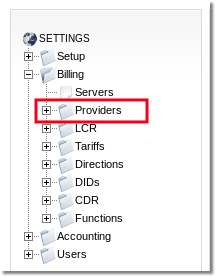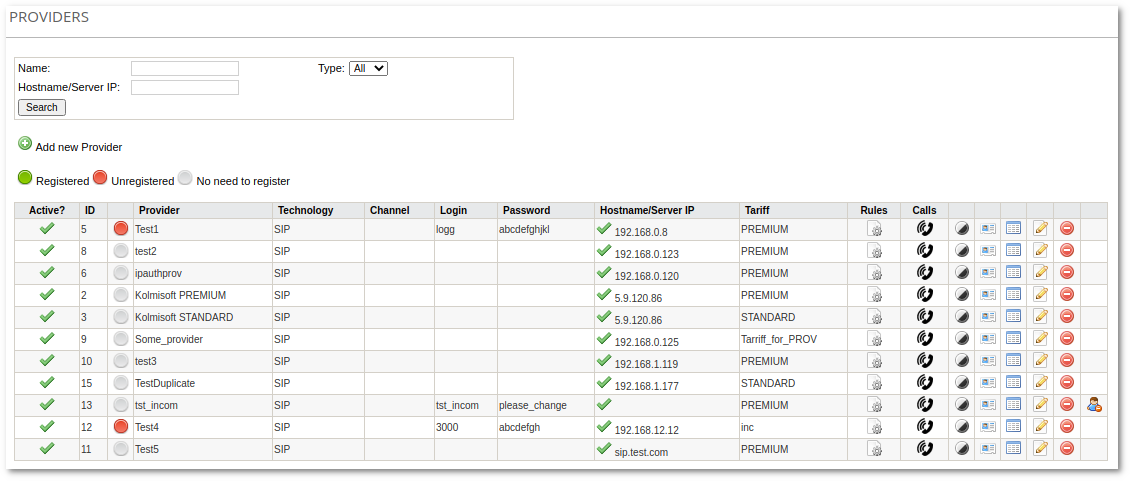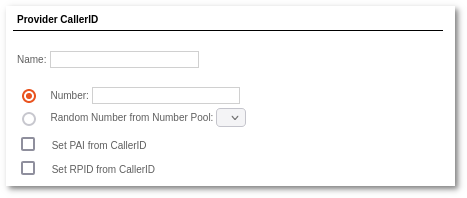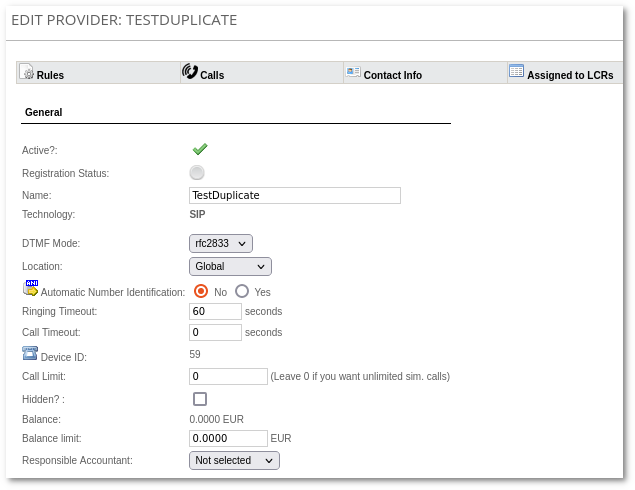Difference between revisions of "Providers"
| Line 130: | Line 130: | ||
* '''Common Use''' – Provider can be used by Resellers which are able to create their own Providers. Reseller will be billed using this Provider. If provider is marked as common use and is used in one of reseller's LCR or is in Terminators list - admin is not allowed to delete this provider or remove common use option. | * '''Common Use''' – Provider can be used by Resellers which are able to create their own Providers. Reseller will be billed using this Provider. If provider is marked as common use and is used in one of reseller's LCR or is in Terminators list - admin is not allowed to delete this provider or remove common use option. | ||
* '''Transport''' – lets you choose protocol <nowiki>[tcp, udp]</nowiki> for data transfer. Appears only if Provider is SIP and when Asterisk 1.8 is enabled. Default value: ''udp''. | * '''Transport''' – lets you choose protocol <nowiki>[tcp, udp]</nowiki> for data transfer. Appears only if Provider is SIP and when Asterisk 1.8 is enabled. Default value: ''udp''. | ||
* '''Time limit per day''' - Total time available for provider per day. When limit is reached another provider in LCR is used. | |||
* '''Limit up to X, during Y seconds''' – you can set limit how many calls (X) can be done in some interval of seconds (Y). [[Last Calls]] will show '''FAILED([[Hangupcause Codes |243]])'''. | |||
<br><br> | <br><br> | ||
=== SIP Specific === | === SIP Specific === | ||
| Line 142: | Line 144: | ||
* '''P-Asserted-Identity usage''' – The P-Asserted-Identity header field can be used to convey the proven identity of the originator of a request within a trusted network. | * '''P-Asserted-Identity usage''' – The P-Asserted-Identity header field can be used to convey the proven identity of the originator of a request within a trusted network. | ||
* '''Periodic check''' - Turns on or off functionality which disables provider if it is unreachable. | * '''Periodic check''' - Turns on or off functionality which disables provider if it is unreachable. | ||
<br><br> | <br><br> | ||
Revision as of 11:59, 12 October 2013
Description
In the old PSTN world, Providers were called Trunks. Providers are your route out of your VoIP network to the outside world.
Providers can be one of several types: ZAP, SIP, IAX2, and H323. The type determines which technology is used to connect to the Provider.
At the very start, you need to create a Provider through which you will dial out to PSTN or other VoIP networks.
Every Provider will charge you for calling a destination through his service (although the rate might be zero). The rate to every destination is different. Because of this, we need to have a Tariff (or Price List) for each Provider. This Tariff will tell our billing what price we will pay to a destination when using this Provider's services. In other words, this will be our Selfcost.
Usage
Go to SETTINGS –> Billing –> Providers.

Here you can see a list of all Providers:

- Click
 New Provider to create new Provider, enter the Name for a new Provider, select its Technology, Tariff, Asterisk server which should be used for this provider and click Create.
New Provider to create new Provider, enter the Name for a new Provider, select its Technology, Tariff, Asterisk server which should be used for this provider and click Create. - Click
 icon to change settings for old Provider.
icon to change settings for old Provider. - Click
 icon to disable Provider and it will not be used while it is cross in Active column. It affects only outgoing calls. Incoming calls from this provider will be accepted.
icon to disable Provider and it will not be used while it is cross in Active column. It affects only outgoing calls. Incoming calls from this provider will be accepted. - Click
 icon to enable Provider if you want to use it again.
icon to enable Provider if you want to use it again.
NOTE:
- You can't create a new Provider if there are no Tariffs available for Providers.
- A Provider is also able to send calls, not just receive them. More info here. In case you want to sell services to a provider you have to create such a provider.
Settings
General
- Name – a name for the provider, for informational purposes.
- Technology – out of SIP/IAX2/ZAP/H323, choose which technology your provider uses - that is, the way you connect to the provider.
- Tariff – the list of rates the provider charges you.
- DTMF Mode – the available options are inband, info, RFC2833, and auto. Choose the one used by your provider.
- Location – which Localization rules are set to apply to INCOMING calls COMING FROM this provider.
- Automatic Number Identification - used in a special case explained here: Provider with ANI
- Ringing Timeout – this setting lets you set for how long this provider should be dialed before giving up. The default value is 60 seconds, and the minimum value is 30 seconds.
- Call Timeout – this setting lets you set the duration of the whole call: ringing and the period after connection.
- Device ID – informational data.
- Call limit – explained here: Simultaneous call limitation.
- Hidden? – hide/unhide provider
- Balance – provider balance. Provider balance increases when calls are made via that provider. Currently it is not available to decrease provider's balance. You can read more about Provider Billing Addon here.
- Balance limit – this is the limit of balance that can be reached by the provider. After he reaches the specified balance, calls aren't sent through this provider anymore. Balance limit value of zero means that balance is unlimited.
Authentication
For ZAP providers
- Channel – which channel (or channel group) to use on a PRI/BRI/PSTN card. Channels and groups should be configured in zapata.conf.
For SIP/IAX2 providers
- Login – username if your provider asks for it.
- Password – password used for authentication by your provider.
- Authenticate by IP – just check the checkbox (Login/Password can be left empty).
- Make sure you put the correct Hostname/IP address!
- Register – should we register the provider? (option is not visible when Dynamic is selected in Network related section)
- Register extension – if the provider asks to use an extension for registration (usually they don't), enter it here.
Provider CallerID
CallerID – consists of two parts: Name and Number. The "Number" part is transferred by default on all technologies (GSM, PSTN, SIP etc), but the "Name" part only on some. The number you see on your mobile phone when someone is calling you is the "Number" part.

- Name – the "Name" part of CallerID.
- Number – the "Number" part of CallerID.
- Random Number from Number Pool – the "Number" part of CallerID selected from Number Pool
.
NOTE: If you have this configured all incoming call from this provider will have that CallerID.
If you leave these fields empty, calls coming from this provider will have CallerID set by the Provider. It should almost always be this way.
- Hostname – hostname of the provider. Subnetting is supported.
- Server IP – the provider's IP. The value can be "dynamic", which means that provider can change its IP. To discover this value, do ping to the provider's hostname.
- Port – port used to connect to the provider (default: 5060 for SIP, 4569 for IAX2, 1720 for H323).
H323 specific network settings
- Fast Start – an option specific to H323; it is either on or off.
- h245 Tunneling – an option specific to H323; it is either on or of
SIP specific network settings
- Media control – canreinvite/transfer. Do you want your server to stay in the media path between your clients and your provider? Disable if you have a lot of 1-second answered calls.
- NAT – the available options are: yes, no, never, and route. For a detailed explanation of these settings, refer to here.
IAX2 specific network settings
- IAX2 Trunking Mode – enable/disable trunking mode, which allows multiple voice streams to share a single "trunk" to another server, reducing overhead created by IP packets. More details here
SIP and IAX2 specific network settings
- Qualify – how often to "ask" the provider about availability. More details here for SIP providers and here for IAX2 providers.
Servers
Allows to select on which Asterisk servers this provider should be used.
Codecs
Choose the codecs your provider uses.
NOTE: When no fields are checked, all codecs are available. (![]() For example, settings in sip.conf or iax.conf are effective).
For example, settings in sip.conf or iax.conf are effective).
Advanced
- Grace time – if call duration is less than Grace Time, it will not be accounted.
- Progressinband:
- yes – when "RING" event is requested, always send 180 Ringing (if it hasn't been sent yet) followed by 183 Session Progress and in-band audio.
- no – send 180 Ringing if 183 has not yet been sent, establishing an audio path. If the audio path is established already (with 183), then send in-band ringing (this is the way Asterisk historically behaved because of buggy phones like Polycom's).
- never – whenever ringing occurs, send "180 ringing" as long as "200 OK" has not yet been sent. This is the default behavior of Asterisk.
- Video support – does your provider support Video over IP? More info here.
- Allow duplicate calls – the default setting is "no".
- Interpret NO ANSWER as FAILED – default option is no (This will change the provider in LCR like it is failed, in last calls you will see
the real hangupcause – no answer)
- Interpret BUSY as FAILED – default option is no (This will change the provider in LCR like it is failed, in last calls you will see
the real hangupcause – busy)
- Fake Ring – should system generate Fake Ring or not? Use only if your Device/Provider has bad protocol implementation and does not send RING signal properly.
- Common Use – Provider can be used by Resellers which are able to create their own Providers. Reseller will be billed using this Provider. If provider is marked as common use and is used in one of reseller's LCR or is in Terminators list - admin is not allowed to delete this provider or remove common use option.
- Transport – lets you choose protocol [tcp, udp] for data transfer. Appears only if Provider is SIP and when Asterisk 1.8 is enabled. Default value: udp.
- Time limit per day - Total time available for provider per day. When limit is reached another provider in LCR is used.
- Limit up to X, during Y seconds – you can set limit how many calls (X) can be done in some interval of seconds (Y). Last Calls will show FAILED(243).
SIP Specific
- Fromuser – more details
- Fromdomain – more details
- Trustrpid – This defines whether or not Remote-Party-ID is trusted. It's defined in http://tools.ietf.org/id/draft-ietf-sip-privacy-04.txt
- Sendrpid – defines whether a Remote-Party-ID SIP header should be sent. It defaults to "No". This field is often used by wholesale VoIP providers to provide calling party identity regardless of the privacy settings (the From SIP header).
- Insecure – more details
- T.38 Support – should we support T.38 pass-through?
- SIP 302 Reinvite Support – turns this SIP feature on or off.
- P-Asserted-Identity usage – The P-Asserted-Identity header field can be used to convey the proven identity of the originator of a request within a trusted network.
- Periodic check - Turns on or off functionality which disables provider if it is unreachable.
Debug
- Save Call Log – when this option is enabled you can access Call info information in last calls page.
See also
- H323 Provider settings
- Quick Providers changes
- Providers Statistics
- NO ANSWER/BUSY interpretation for providers
- I have a problem with Provider

